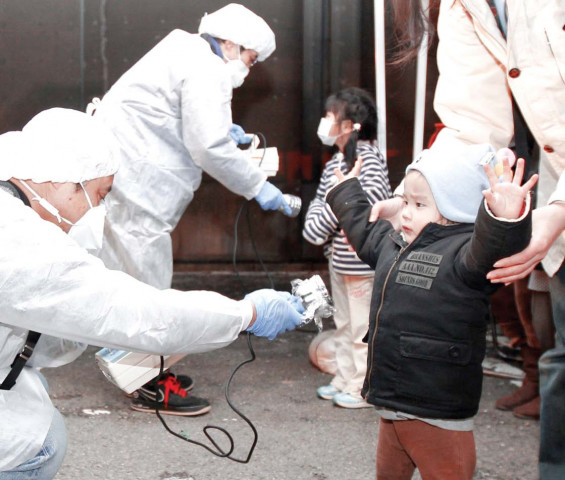
An explosion at a Japanese nuclear plant triggered fears of a meltdown on Saturday, after a massive earthquake and tsunami left more than 1,700 dead and at least 10,000 missing in the port town of Minamisanriku in quake-hit Miyagi prefecture.
As workers doused the stricken reactor with sea water to try to avert catastrophe, Japan’s Prime Minister Naoto Kan said the chaos unleashed by Friday’s 8.9-magnitude quake was an “unprecedented national disaster”.
Radiation leaked from the plant, but the government moved to calm fears of a meltdown, saying that the blast did not rupture the container surrounding the reactor and that radiation levels had fallen afterwards.
At least three residents evacuated from a town near the nuclear plant have been exposed to radiation, media reports said. The three were randomly chosen for examination out of some 90 bed-ridden patients moved from a hospital in the town of Futaba-machi, public broadcaster NHK reported. More cases are expected.
Thousands of people were scanned for radiation exposure as officials struggled to cope with the aftermath of the disaster.
The Nuclear and Industrial Safety Agency rated the accident at the nuclear plant at four on the international scale from 0 to 7, an official said. On the International Nuclear Event Scale, a level four incident means a nuclear reactor accident “with local consequences”. The 1979 Three Mile Island accident in the United States was rated five while the 1986 Chernobyl disaster was a seven.
An explosion sent plumes of smoke spewing from the ageing Fukushima No 1 plant in northern Japan, raising fears of a possible meltdown a day after the facility’s cooling system was damaged in a massive quake. “Right now we are considering the accident should be rated four,” said the agency official. “The rating may be changed in accordance with the development of the condition”.
The operator Tokyo Electric Power (Tepco) pumped water into the plant and released steam to depressurise the hut containers, an action that experts say will release a certain amount of radioactive vapour.
Tepco said that, at its highest level, the hourly radiation inside the plant reached 1,015 micro sievert before the blast – equivalent to the permissible exposure for people over one year.
Kyodo and Jiji reported before the explosion that the plant “may be experiencing nuclear meltdown”, while NHK quoted the safety agency as saying metal tubes that contain uranium fuel may have melted.
Japanese authorities have told the UN’s atomic watchdog they are making preparations to distribute iodine to people living near nuclear power plants affected by Friday’s earthquake, the Vienna-based agency said.
Iodine can be used to help protect against thyroid cancer in the case of radioactive exposure in a nuclear accident. After the 1986 Chernobyl disaster, thousands of cases of thyroid cancer were reported in children and adolescents who were exposed at the time of the accident.
In Paris, the French Nuclear Safety Authority said favourable winds will likely blow possible radioactive pollution from a blast at a Japanese nuclear power plant out over the Pacific Ocean.
“The wind direction for the time being seems to point the (nuclear) pollution towards the Pacific,” Andre-Claude Lacoste told journalists.
Kyodo News said about 300,000 people were evacuated nationwide. As many as 3,400 buildings were either destroyed or badly damaged, Kyodo reported.
Published in The Express Tribune, March 13th, 2011.


















COMMENTS
Comments are moderated and generally will be posted if they are on-topic and not abusive.
For more information, please see our Comments FAQ